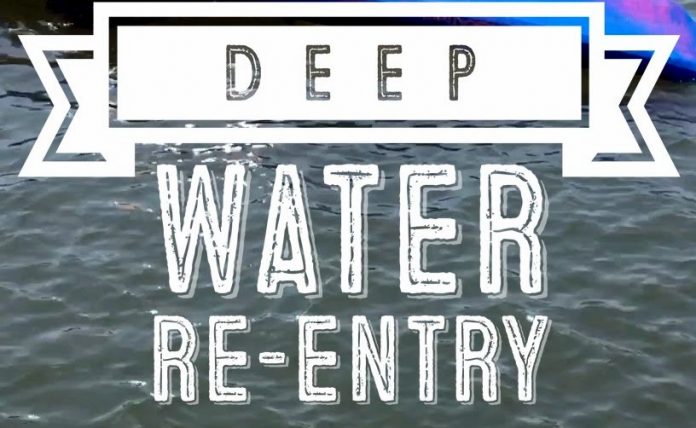Solo deep water reentry of a sit-on-top kayak
Neil Taylor, Guide Services-Strike Three Kayak Fishing
www.strikethreekayakfishing.com
www.capmel.com
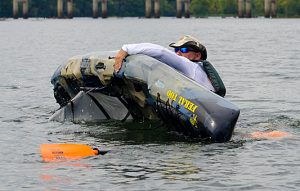
Before you take your first trip to do some kayaking or kayak fishing, one crucial safety preparation one needs to consider is “How am I going to get back in to my craft if I end up ejected from my boat in water that is too deep to stand?” Instruction is a great way to get the knowledge and technique you need but nothing is more important than “practice.” Kayak shops will often include a course that covers this technique included in the purchase of a new craft but you can also pay to get the valuable, potentially life-saving instruction and information.
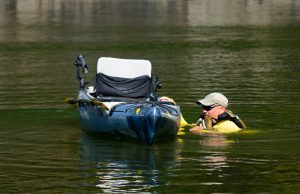
For the kayak angler, knowing how to reenter the watercraft without flipping it is also a cost saving skill. Taking a little swim is a lot less frustrating later on if you didn’t lose a thousand dollars in rods, reels and other equipment. If you haven’t done this, set up a controlled situation and practice it
First off, if you end up in the water and you weren’t already wearing your personal flotation device (life vest), get it on! In conditions where you would have ended up in the water with waves and wind, wearing the PFD is a good idea. If not wearing your PFD it should always be easily accessible and never “stored” or buried in other equipment. There are auto-inflate vests available that will inflate should you end up in the water.
Secondly, secure your paddle (you’ll need it later!) A paddle leash is a great item for always keeping your paddle from escaping. Paddle clips or bungee strap systems will also keep your paddle secure during your reentry.
Note: Place your vest in an easily accessible location while you are out there (if you aren’t wearing it). You get out of your craft and then you’ll see if your vest is sufficiently accessible. You also get the practice of putting on the vest while in the water (and other things you wouldn’t think about like “securing the paddle”, what of my other gear am I in peril of losing by a bad reentry attempt?). Once the vest is on, reentry really isn’t that difficult.
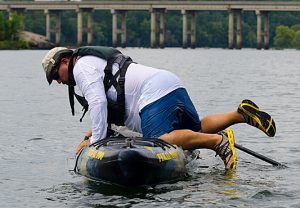 Having a grip of that far side of the rail is key. No real grip on the far side of the boat, this process is going to become exceedingly difficult.
Having a grip of that far side of the rail is key. No real grip on the far side of the boat, this process is going to become exceedingly difficult.
Flotation bags and paddle floats are items that help with stability of kayaks for deep water reentry. Oversized paddle floats can be an excellent part of the deep water reentry solution. Any extra buoyancy is helpful. Self-draining sit-on-tops are not as difficult but hybrid boats require a different plan. Think ahead! This can make this process easier. Do you know what to do? Do you have what you need? I can lash my vest to the end of a paddle and use a rope to tie the paddle off securely to the deck of the boat. Adding stability for reentry, this can make a big difference. 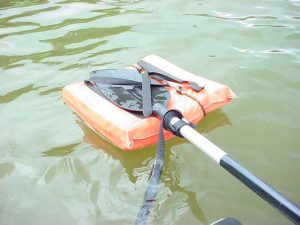
Reentry has a great deal more to do with technique than it does arm and torso strength. “Learning your boat” is also important. Different kayak models have different stability and “grab points” that make practicing this technique in the boat you will be using a smart way to prepare for this situation.
Many kayaks have side handles on them. Getting a grip on the far side of the boat is important to keeping the balance of the boat as you get prepared to get back in. The buoyancy of your PFD also helps this process, floating you up to the surface alongside the kayak. If your kayak doesn’t have side handles you might consider adding them. 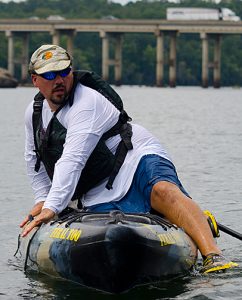
Now you are in position. The technique from here is where the practice will pay off in the process of reentry. While holding on to the far side of the kayak, start kicking with your feet, pull yourself up when you feel you have generated some power to propel yourself on top of the kayak. Belly-down, you should be able to get “up on top” and feel the boat steady itself when you reach the center of the cockpit area of the kayak.
From this position, you just need to smoothly make a rollover so that you are then seated or sidesaddle in your kayak.
With practice, it’s easy. While many people never find themselves in this situation, it’s great to have the technique and confidence in your reentry skills just in case you need to use it.
The boat you have can make a difference. 
Above is general philosophy with a regular kayak. If you are like me and you have the Native Ultimate, it is a different game. Higher rails, this is a more difficult boat to remount if you are in the water. Big item to note: For some of the hybrid boats I suggest that if there is a substantial amount of water GET TO SHORE or shallow water immediately and work on water removal before you cross any deep waters or enter current/waves/windy situations. Avoid “critical point”. Critical point: That’s the amount of water weight combined with your equipment added to the boat where the boat will drop down to the water line. Also known as “sunk.” The goal, make sure you never get to critical point with the theme, find a place to get out of the boat. For lesser amounts of water you should be able to do some bailing to keep the boat away from Critical Point.
Marco Lavalle, who passed away last year, he flooded his Ultimate when he was out with me. It floated him out of the boat but it WOULD NOT have happened if he listened to me. My notes from that day: “Marco will tell you that had he listened to me and just dumped the anchor, he wouldn’t have had the side-spill of water coming into the boat. He didn’t flip it, it filled with water. The twelve dollar anchor loss would have been better than the two fishing rods.” Me there, I had Marco hold onto his boat, I roped it and I towed him to shallow water.
 Flipping isn’t the issue with these boats. Filling with water is a problem. I have a hand pump and I’ll pump water out if there is some in my boat. But if I have winds, waves and have some water in that boat, I’ll be thinking about a shallow area to get to. When a certain amount of water gets in the boat, with the weight of the occupant and his or her gear, that boat will start to settle deeper into the water and then list to one side dumping the person out.
Flipping isn’t the issue with these boats. Filling with water is a problem. I have a hand pump and I’ll pump water out if there is some in my boat. But if I have winds, waves and have some water in that boat, I’ll be thinking about a shallow area to get to. When a certain amount of water gets in the boat, with the weight of the occupant and his or her gear, that boat will start to settle deeper into the water and then list to one side dumping the person out.
One thing about the Ultimate. Most water comes into it while plowing into waves. “Wave watching” helps and going slower when going down a swell and then slightly angling the boat just a little keeps the bow from really digging into a wave.
The other thing about the water coming in while you’re “moving forward”. If you are in some bounce, just stop paddling or just paddle hard enough to stay in place. I have my “bailing cup” always laying in my boat so I’ll scoop out a little bit of water that’s in there if I take those breaks in the bouncier waves.

But without a doubt, anyone who is in that situation in the Ultimate should be asking themselves: “Where is the shallow water?” And if they take on enough water, they should be getting there immediately, dismount and then get some water out of it before it swamps.
Access to shallow water and knowing that’s where you’re going to go if you’re close to that problematic stage is going to prevent filing the boat to “critical point.” Make good decisions.
Another overlying problem: Before reentry do you have to remove some water from this boat? You may have to. If you have an Ultimate, you should probably practice this. I would say that you want to have the boat mostly dry before you attempt a deep water reentry.
I do have some bigger pieces of Styrofoam that I’ve used for elevating some equipment. I probably have the other elements necessary to turn those into a paddle float. I know that if I absolutely had to, I could utilize those blocks to attach to the ends of paddles to make a stabilizer that would be helpful in deep water reentry. But I’m saying that with the amount of gear I have in the boat and “situationally”, that’s going to be a problem getting the water out of that boat before I could even try the reentry. So I still say the goal is to be ready to get to shore.
Know your risk you’re taking. The Ultimate isn’t self-draining. If you’re going off a beach for a tarpon, that’s water that’s “over your head”. So, if you fill with water out there, you either have to be lucky and have wind and current taking you back to the beach….OR this becomes a “rescue” situation.
Just be aware. I don’t tout the boat as a “deep water” boat. I never will. People who do use it that way can get away with a lot but if they hesitate when they get to critical load with water nearly up above the tunnel hull: It becomes a rescue situation. I’ve been able to simulate water removal and deep water reentry. But not in current, waves, wind or with any gear in the boat. Take it for what it’s worth. If you’re going into deep waters, have the sense to head in when things “just aren’t good.”
Do your friends have a tow rope? That’s one more item to have. It’s going to be a chore to tow an Ultimate full of water but if you
1) can get all your other gear out of it
2) have some added flotation
you should be able to shake enough water out of it “canoe style” to feasibly lighten it up so someone can tow your boat back to the shallows.
When I am removing substantial amounts of water from my Ultimates, I’ll sit on the end of the boat at the stern and gravity will bring all the water there. It pools it up to do the job better.
The Ultimate is a safe boat. The beauty of it: It won’t flip. I make it a point of telling people that they need to know where they’re going to go if they’re getting that much water in with them. If you want to know why I feel the way I do, run your own tests in a controlled area. Fill her up with water and then try going through the process of reentering that boat. You have to get the water out of it before you can get back in it. I’d rather do that some a shoreline than while treading water.
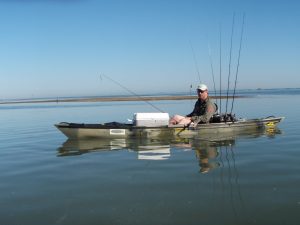
Reentry is similar to what you’d do with a sit-on-top, you just have a higher edge to get over. It sounds like you’re a natural. Reentry can be a bear, especially for someone who has never tried it. I do like the Ultimates for a lot of reasons but for ease of getting in and out and “lifting” these boats, it’s great to be able to grab on to various areas of that gunnel rail.
Other tips and ideas:
A 5 gallon bucket. Filled with water, upside down on the bottom: A bucket is a ladder. It isn’t going to help much in water that’s over four and a half feet deep and this is reentering a boat without water in it but it does work in those “medium depths” where reentry is tough to do.
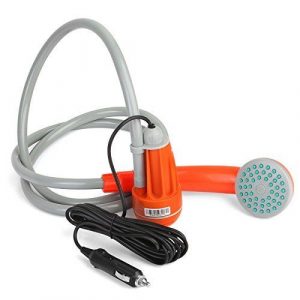 Battery operated water removal or manual? I would always have a manual method available. A hand pump. For me, the Native Ultimate, my coffee cup has been my main bailing device for years. For people who are going to do deep water trips without access to shore, the pump system is a great idea. It needs to be reliable, not something that’s going to fail if it gets submerged. Batteries must be ready for powering the pump.
Battery operated water removal or manual? I would always have a manual method available. A hand pump. For me, the Native Ultimate, my coffee cup has been my main bailing device for years. For people who are going to do deep water trips without access to shore, the pump system is a great idea. It needs to be reliable, not something that’s going to fail if it gets submerged. Batteries must be ready for powering the pump. 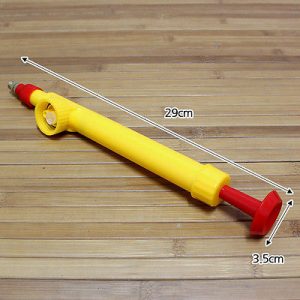
The swim flippers thing is a great thing to consider as an accessory. Without a doubt. Better acceleration and lift to elevate into the boat once the water is removed.
Dump the anchor: Safety is always first. Detaching from a hung anchor should not be a problem if you do NOT run a line through a ring. If you do, you’d better have a knife immediately available. I’d suggest you don’t do it at all.
If you are pulling on a rope at the side of any vessel, but particularly a small one like a kayak, you have some problems looming in high wind and/or current. ABSOLUTELY you can just “let go” and all the stability returns and you will not take on more water. A $20 anchor/rope/clip is a lot cheaper than losing everything you own and being in the water and swimming back to shore.
Do you have a dry bag? Keys, wallet, cell phone (rescue tool) should all be in a SEALED dry bag (the merits of the dry bag only apply if you clip it shut every time). I say “A dry bag is not a humidor” even though when you look in mine you might see some sea gars, and your cell phone will not work if it is wet. 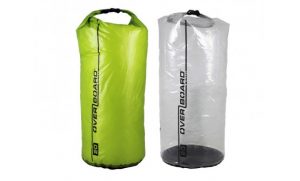
“Where do you keep things?” One of my clients will tell you, I saved him not once but multiple times. He wanted to use his own boat. While I wasn’t impressed with his boat, I let him do it. Before we set out I said “Let’s change a few things.” I clipped off devices and I slid other things into more secure positions. 20 minutes later: Whoosh. A tipover. Items he would have lost were safely secured in the positions I put them. Ask yourself: What will I lose if I flip? For subsequent trips he secured his gear, saving him because that was not the last time he flipped over. Now, he owns a boat that is much less likely to capsize.
Wear your vest, particularly when you are alone. But what’s your plan if you do end up in the water and have abandoned ship? Vest on and swimming to shore with your dry bag sealed is much better than losing everything: Your equipment, your kayak or canoe and most importantly your life. No ability to reach shore, this is when Deep Water Reentry is crucial.
Are you in a vessel that flips a lot? A very unstable boat (not recommended) you may benefit from attaching a mesh bag to the side of the boat. During flipovers you can use the mesh bag to secure items that have been ejected from the boat.
Taking an anchor? You have a flipover, don’t move the anchor. Items that sink will be distributed around that anchor.
Hybrid boats and water removal: Make it easy. Use gravity: For water removal, absolutely being somewhere shallow enough to stand is great. But in my simulations, I’ll get to the stern and lean on it to let gravity bring the water to me. It’s cumbersome but I can get enough water out to allow reentry. But, this is a much more difficult task if you are in a situation where there is wind, waves and/or current.
Get out and enjoy the great outdoors. But don’t do it like an idiot. Make preparations. Be ready for the “worst case scenario.” Better to know what to do and survive than to be on the evening news.
Neil Taylor
Owner and guide: www.strikethreekayakfishing.com
(Cell) 727-692-6345 LivelyBaits@aol.com
Owner and site administrator: www.capmel.com
Neil is an outdoor writer, speaker, web site owner and conservationist in the Tampa Bay area. Instructional kayak fishing charters are his specialty: “All lures, all the time.” 
- The Neil Blog… - July 26, 2023
- The Catfish - July 26, 2023
- update - July 22, 2023
